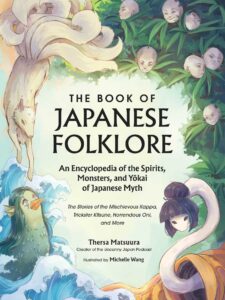subtitled An Encyclopedia of the Spirits, Monsters, and Yokai of Japanese Myth: The Stories of the Mischievous Kappa, Trickster Kitsune, Horrendous Oni, and More.
 Happy Asian American and Pacific Islander Heritage Month! This year, I have a big slate of topical books by AAPI authors and artists (and adjacent) that I’m hoping to be able to spotlight here, beginning with this delightful and informative illustrated volume of supernatural beings out of Japanese folklore.
Happy Asian American and Pacific Islander Heritage Month! This year, I have a big slate of topical books by AAPI authors and artists (and adjacent) that I’m hoping to be able to spotlight here, beginning with this delightful and informative illustrated volume of supernatural beings out of Japanese folklore.
Thersa Matsuura is an American expat living in Japan whose popular podcast Uncanny Japan covers the strange myths and creepy lore of her adopted country. Now she’s compiled some of that knowledge into book form, covering dozens of Japanese mythical creatures and heroes in alphabetical order for easy reference and absorbing reading. From the legendary sorcerer Abe no Seimei to the trickster spirits known as Zashiki Warashi, this is a guide to the most common not-entirely-human figures out of popular Japanese tradition.
Each entry gets an Overview, a segment on its Background and Popular Stories, then a section on appearances In Modern Stories. As someone who has greatly enjoyed playing various Pokemon games over the years, learning the inspirations for some of my favorite pocket monsters made the book feel even more immediate and relevant to me. Interestingly, there wasn’t a huge amount of overlap between the stuff covered here and all the knowledge I absorbed while playing the East Asian-inspired Legend Of The Five Rings CCG and RPG, tho in fairness that’s likely due to L5R being designed almost entirely in the US (and tended to focus on high drama rather than supernatural whimsy.)
The figures that are covered in The Book Of Japanese Folklore run the gamut from whimsical to terrifying, presenting an overview of the country’s culture through the ages, as well as its traditional attitudes towards the spirit realm. One theme that struck me was how anything — people, animals, even inanimate objects — could become supernatural merely by virtue of existing long enough. #Goals, tbh. As a mythology aficionado, it’s fascinating for me to read of real, historical people becoming superpowered beings, in much the same way that many other cultures venerate their human heroes by turning them into demigods and saints. It was also very neat to read of it happening in reverse, as with the magical child Kintaro growing up to become the much more mundane if still legendary warrior Sakata Kintoki. Arguably, that could just be retroactive burnishing, but it is notable that his historical fellows did not get anywhere near the same PR.
The research behind this book is tremendous. Ms Matsuura takes pains to discuss the first recorded origins of each of her entries, and examines their variants as well as the possible influences behind their first appearances. It’s excellent folkloric work and, perhaps more importantly, is passed on in a way that’s readily accessible to the lay reader. The author also freely references her predecessors in the field of Japanese folklore compilation and urges readers to check out their works as well.
Michelle Wang’s beautiful art accompanies many of these entries. I hesitate to call her work anime-inspired because they are, after all, print images, but the full color illustrations have a lovely sense of composition and flow that feels far closer to a Studio Ghibli storyboard than to your usual black-and-white comic. Which is not at all a knock on manga! My appreciation of that art form is actually what convinces me that this art is very much not that.
If you’ve ever wanted to learn more about the supernatural characters of Japanese folklore, I cannot recommend this book highly enough as your entryway into the subject. Written with an excellent balance of story and history, it’s the perfect jumping off point to learning more about the stories that permeate Japanese culture.
The Book of Japanese Folklore by Thersa Matsuura & Michelle Wang was published yesterday April 30 2024 by Adams Media and is available from all good booksellers, including
